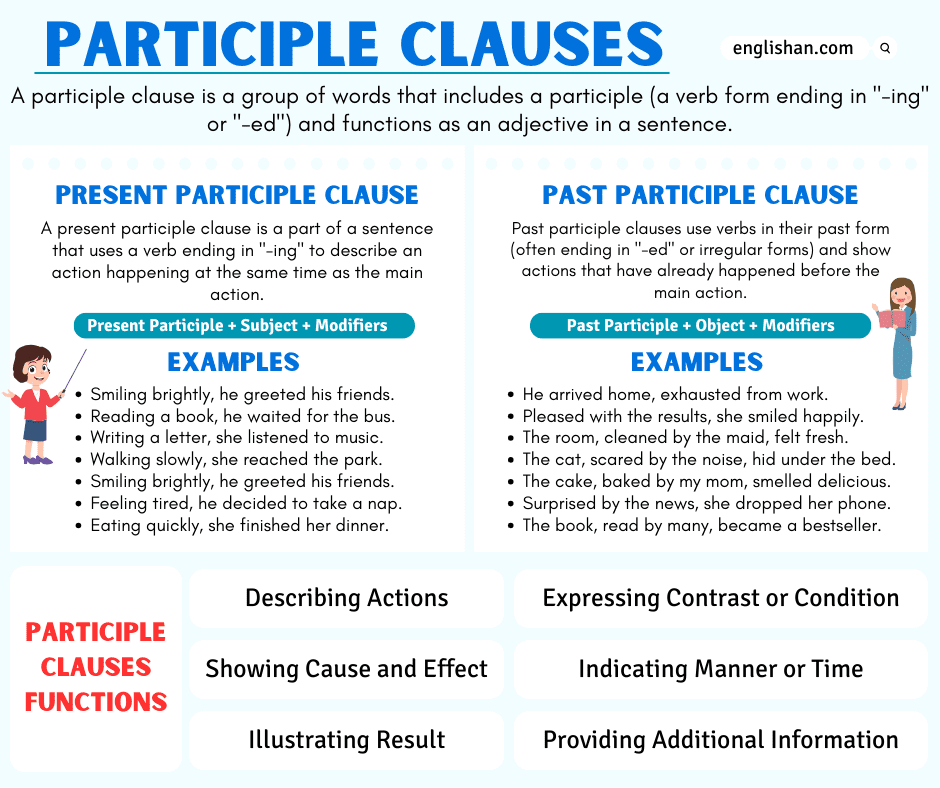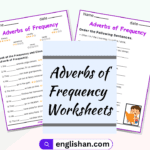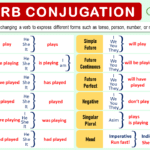A clause is a group of words that contains a subject and a predicate, conveying a complete thought. Among various types of clauses, participle clauses are notable for their unique structure and function. These clauses use participles, which are formed from verbs and function as adjectives, to create a specific relationship between the main clause and the additional information provided. In this article, we will explore participle clauses, their function, uses, and examples to help you understand this grammatical concept better. Let’s get started!
Understanding Participle Clauses
Before we discuss our main topic (Participle Clause), let’s first understand the basics.
What Is a Participle?
A participle is a form of a verb that functions as an adjective. It describes or gives more information about a noun or pronoun in a sentence. It often ends in ‘-ing’ (present participle) or ‘-ed’ (past participle). For example, “The running water” (present participle) or “The baked bread” (past participle).
What Is a Clause?
A clause is a group of words that has a subject and a verb. It can express a complete thought (independent clause) or function as a part of a sentence (dependent clause). For example, “She ate pizza” is a clause because it has a subject “She” and a verb “ate” and makes sense on its own.
What Is a Participle Clause?
A participle clause is a group of words that includes a participle (a verb form ending in “-ing” or “-ed”) and functions as an adjective in a sentence. It describes or gives more information about a noun or pronoun. For example, in the sentence “The boy, holding a balloon, smiled,” the phrase “holding a balloon” is a participle clause modifying the noun “boy.”
These clauses can be used to provide extra information, such as time, reason, or condition, in a sentence. They can appear at the beginning, middle, or end of a sentence, depending on where the emphasis is needed. They often make sentences more interesting by adding descriptive information. Here are some example sentences:
- Eating dinner, the family watched TV.
- Exhausted from work, she fell asleep.
- Playing in the park, the children laughed.
- She, sitting quietly, listened to the lecture.
- Confused by the question, he asked for help.
Types of Participle Clauses
There are two basic types of Participle Clauses:
Present Participle Clauses
Present participle clauses use verbs ending in “-ing” and show actions happening at the same time as the main action. For example, “Walking to school, she saw her friend.” Here, “walking to school” is a present participle clause because it describes what she was doing at the same time as seeing her friend.
- Smiling brightly, he greeted his friends.
- Reading a book, he waited for the bus.
- Writing a letter, she listened to music.
Past Participle Clauses
Structure of Participle Clauses
Participle clauses typically consist of a participle (either present or past), a subject, and sometimes an object, and sometimes it’s connected to the main sentence by a word like “while,” “when,” or “after.” They can come at the beginning, middle, or end of a sentence, depending on what you want to emphasize. Here is the basic structure:
Participle Clause = Participle + Subject ( + Object ) + Connection
Here’s an example:
- Main sentence: “She cooked dinner.”
- Participle clause: “Using fresh ingredients.”
- Combined sentence: “She cooked dinner using fresh ingredients.”
How to use Participle Clauses?
- Understand the Participle Clause: It adds extra information to the main clause, usually about the same subject.
- Choose the Correct Participle: Used (-ing) for actions happening at the same time or before the main action. Use the past participle (-ed) for actions that happened before the main action.
- Placement: Place the participle clause close to the noun it describes to avoid confusion.
- Join with the Subject: Use the -ing or -ed word to join it with the subject (the doer of the action). You can use words like “while,” “when,” “after,” or “before” to connect them.
- Drop Pronouns: You can drop pronouns (like “he” or “she”) if it’s clear who you’re talking about.
- Use Commas: Use commas to separate the participle clause from the main clause if it comes before the main clause.
- No Commas Needed: In most cases, you don’t need commas to separate the participle clause from the main clause.
- No Need for Conjunctions: Often, you don’t need words like “while,” “when,” or “before” to connect them to the main sentence.

Functions of Participle Clauses
- Describing Actions: Participle clauses describe actions that are related to the main action.
- Example: Playing football, he twisted his ankle.
- Providing Additional Information: They give extra details about the subject or object.
- Example: Tired from school, Sarah slept early.
- Showing Cause and Effect: They also indicate the reason or result of the main action.
- Example: Feeling unwell, she stayed home.
- Expressing Contrast: They highlight differences between actions or situations.
- Example: Though tired, he continued working.
- Denoting Conditions: They often express specific conditions or circumstances.
- Example: Given the chance, he’ll join us.
- Indicating Manner: They describe how an action is performed.
- Example: He ran fast, breathing heavily.
- Highlighting Simultaneous Actions: They emphasize actions happening at the same time.
- Example: She laughed, tears rolling down.
- Illustrating Result: They show the outcome or consequence of an action.
- Example: The cake burnt, filling the kitchen with smoke.
- Specifying Time: Sometimes they indicate when an action takes place.
- Example: Leaving late, she missed the bus.
- Clarifying Relationships: They clarify the relationship between different actions.
- Example: Playing football, he twisted his ankle.
Participle Clause vs Participle Phrase
A participle clause includes a participle along with its related words, forming a mini-sentence with its subject and verb. For example, “Walking slowly, he reached the bus stop.” Conversely, a participle phrase consists only of the participle and its modifiers, lacking a subject-verb relationship. In the sentence “Smiling happily, she waved at her friend,” “smiling happily” is a participle phrase adding a description to the main action without forming a complete sentence on its own.
Participle Clauses Example Sentences
- Walking slowly, she reached the park.
- Smiling brightly, he greeted his friends.
- Feeling tired, he decided to take a nap.
- Running late, she hurried to catch the bus.
- Running late, they hurried to catch the train.
- Eating quickly, she finished her dinner.
- Reading quietly, Sarah sat under the tree.
- Painting the fence, Dad whistled happily.
- Watching TV, he fell asleep on the couch.
- Stirring the soup, she added more spices.
- The room, cleaned by the maid, felt fresh.
- Tasting the soup, she added a pinch of salt.
- Driving carefully, he reached his destination.
- The cake, baked by my mom, smelled delicious.
- Surprised by the news, she dropped her phone.
- The book, read by many, became a bestseller.
- The cat, scared by the noise, hid under the bed.
- Dressed in his best suit, he attended the party.
- Surprised by the news, she dropped her phone.
- Laughing loudly, the children played in the yard.
- Prepared for the presentation, she felt confident.
- Disturbed by the noise, the baby woke up crying.
Participle Clauses Exercises
- The kids were playing in the yard, _______ (laughing / laughed).
- _______ (Finishing / Finished) his dinner, Jack went to watch TV.
- The dog slept _______ (peaceful / peacefully) by the fireplace.
- _______ (Lost / Losing) in thought, Sarah missed her bus.
- The cake, _______ (baked / baking) by Mom, smelled delicious.
- _______ (Surprised / Surprising) by the loud noise, the cat hid under the bed.
- The birds, _______ (singing / sang) in the tree, woke me up.
- _______ (Worried / Worrying) about the exam, Sana couldn’t sleep.
- The flowers, _______ (watered / watering) daily, grew beautifully.
- The car, _______ (driven / drove) by Dad, reached the destination.
Answers:
- laughing
- Having finished
- peacefully
- Lost
- baked
- Surprised
- singing
- Worrying
- watered
- driven
FAQs
Q1. What is a participle clause?
A participle clause is a phrase that uses a verb form ending in “-ing” or “-ed” to give more information about the main action in a sentence. It often describes the state or circumstances related to the main action.
Q2. How do participle clauses work?
Participle clauses provide additional information about a noun in the main clause. They often describe actions that are happening at the same time as the main action or actions that have already happened.
Q3. What are the types of participle clauses?
There are two main types: present participle clauses (ending in “-ing”) and past participle clauses (ending in “-ed” or other irregular forms).
Q3. Give example sentences of participle clauses.
- Watching TV, I fell asleep on the couch.
- Finished with my work, I went for a walk.
- Lost in thought, she missed her bus.
- Walking slowly, she reached the park.
- Smiling brightly, he greeted his friends.



